
The Cyperaceae are a family of graminoid (grass-like), monocotyledonous flowering plants known as sedges. The family is large; botanists have described some 5,500 known species in about 90 genera – the largest being the "true sedges", with over 2,000 species.

Eichhornia, commonly called water hyacinths, was a polyphyletic genus of the aquatic flowering plants family Pontederiaceae. Since it was consistently recovered in three independent lineages, it has been sunk into Pontederia, together with Monochoria. Each of the three lineages is currently recognized as subgenera in Pontederia:
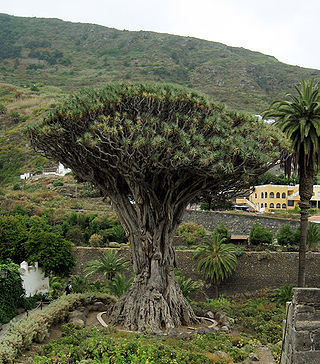
Dracaena is a genus of about 120 species of trees and succulent shrubs. The formerly accepted genera Pleomele and Sansevieria are now included in Dracaena. In the APG IV classification system, it is placed in the family Asparagaceae, subfamily Nolinoideae. It has also formerly been separated into the family Dracaenaceae or placed in the Agavaceae.

Alternanthera is a genus of flowering plants in the family Amaranthaceae. It is a widespread genus with most species occurring in the tropical Americas, and others in Asia, Africa, and Australia. Plants of the genus may be known generally as joyweeds, or Joseph's coat. Several species are notorious noxious weeds.
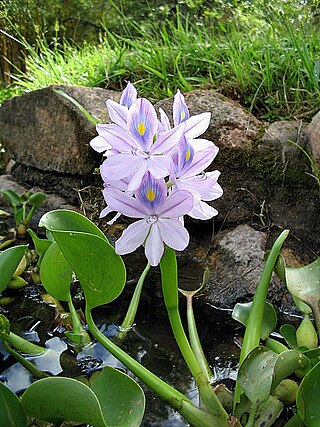
Pontederiaceae is a family of flowering plants.

Cissus is a genus of approximately 350 species of lianas in the grape family (Vitaceae). They have a cosmopolitan distribution, though the majority are to be found in the tropics.

Sterculia is a genus of flowering plants in the mallow family, Malvaceae: subfamily Sterculioideae. Members of the genus are colloquially known as tropical chestnuts. Sterculia may be monoecious or dioecious, and its flowers unisexual or bisexual.

Avicennia is a genus of flowering plants currently placed in the bear's breeches family, Acanthaceae. It contains mangrove trees, which occur in the intertidal zones of estuarine areas and are characterized by its "pencil roots", which are aerial roots. They are also commonly known as api api, which in the Malay language means "fires", a reference to the fact that fireflies often congregate on these trees. Species of Avicennia occur worldwide south of the Tropic of Cancer.
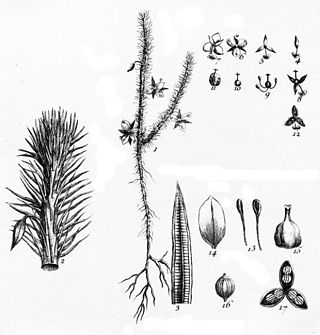
Mayaca is a genus of flowering plants, often placed in its own family, the Mayacaceae. In the APG II system of 2003, it is assigned to the order Poales in the clade commelinids. The Cronquist system, of 1981, also recognised such a family and placed it in the order Commelinales in the subclass Commelinidae.

Echinodorus, commonly known as burhead or Amazon sword, is a genus of plants in the family Alismataceae, native to the Western Hemisphere from the central United States to Argentina. Its scientific name is derived from Ancient Greek echius – "rough husk" - and doros – "leathern bottle" - alluding to ovaries, which in some species are armed with persistent styles, forming prickly head of fruit. Some of the species are commonly cultivated in artificial aquatic habitats.

Gomphrena is a genus of plants in the family Amaranthaceae. They are known as the globe amaranths.
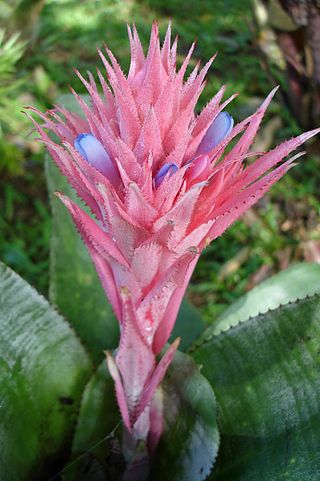
Aechmea is a genus of flowering plants in the family Bromeliaceae. The name comes from the Greek aichme, meaning "spear". Suggested pronunciations include EEK-me-ə and eek-MEE-ə. Aechmea comprises eight subgenera and around 250 species distributed from Mexico through South America and the Caribbean. Most of the species in this genus are epiphytes.

Cleome is a genus of flowering plants in the family Cleomaceae, commonly known as spider flowers, spider plants, spider weeds, or bee plants. Previously, it had been placed in the family Capparaceae, until DNA studies found the Cleomaceae genera to be more closely related to the Brassicaceae than the Capparaceae. Cleome and clammyweed can sometimes be confused.

Pontederia crassipes, commonly known as common water hyacinth, is an aquatic plant native to South America, naturalized throughout the world, and often invasive outside its native range. It is the sole species of the subgenus Oshunae within the genus Pontederia. Anecdotally, it is known as the "terror of Bengal" due to its invasive growth tendencies.
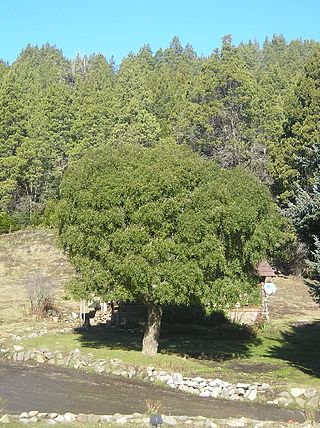
Maytenus is a genus of flowering plants in the family Celastraceae. Members of the genus are distributed throughout Central and South America, Southeast Asia, Micronesia, and Australasia, the Indian Ocean and Africa. They grow in a very wide variety of climates, from tropical to subpolar. The traditional circumscription of Maytenus was paraphyletic, so many species have been transferred to Denhamia and Gymnosporia.
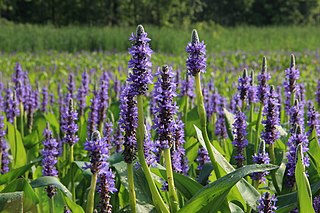
Pontederia cordata, common name pickerelweed (USA) or pickerel weed (UK), is a monocotyledonous aquatic plant native to the Americas. It grows in a variety of wetlands, including pond and lake margins across an extremely large range from eastern Canada south to Argentina. A few examples include northern rivers, the Everglades and Louisiana.
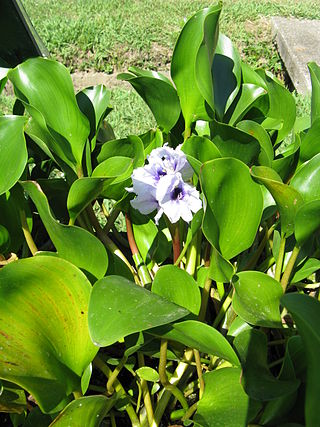
Pontederia azurea is a water hyacinth from the Americas, sometimes known as anchored water hyacinth. It is the type species of Pontederia subg. Eichhornia, which was previously recognized as part of the polyphyletic genus Eichhornia. It is of some interest as an aquarium plant.

Monochoria was originally a genus of aquatic plants in the water hyacinth family, Pontederiaceae. Currently, it has been reduced to a subgenus of Pontederia, Pontederia subg. Monochoria, represented by ten species. Its species are native to tropical and subtropical Africa, Asia, and Oceania. They live in the water or in wet soils. They produce leaves on long petioles and some are cultivated for their attractive flowers. Plants from this species have been utilized in the creation of traditional herbal treatments, food, and cosmetics for a very long time.




















